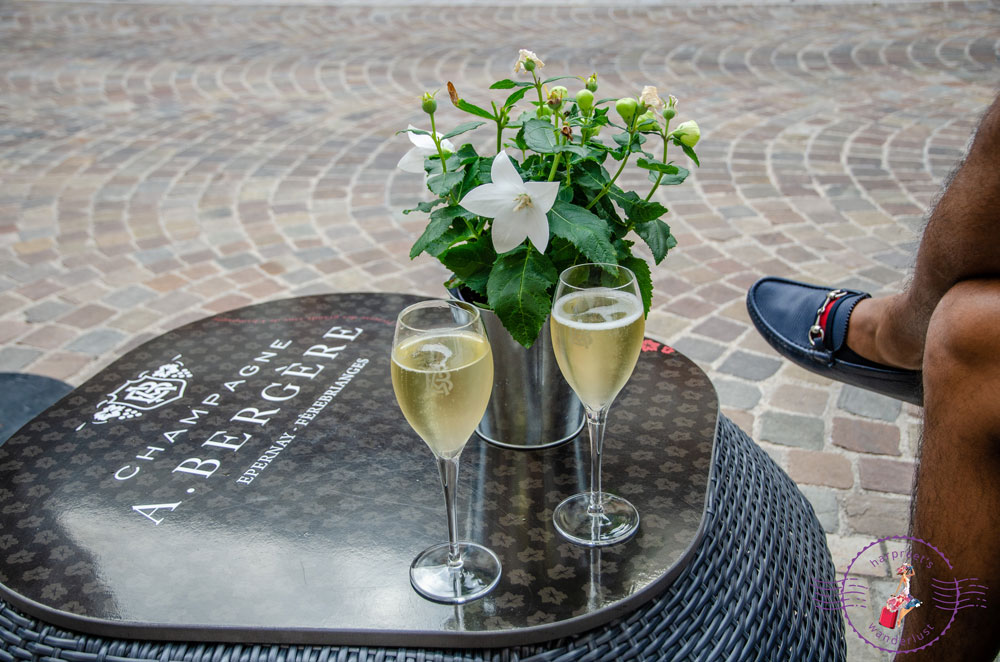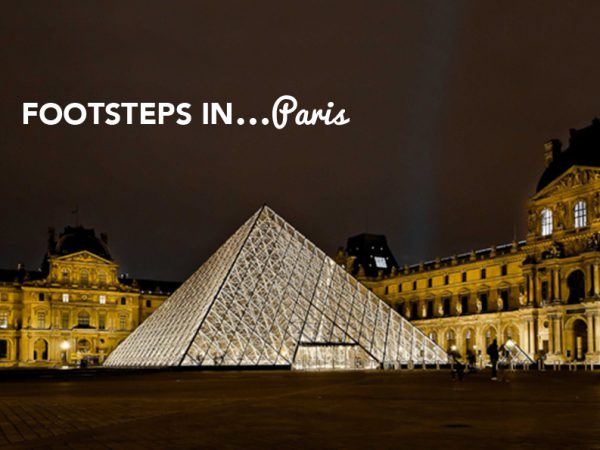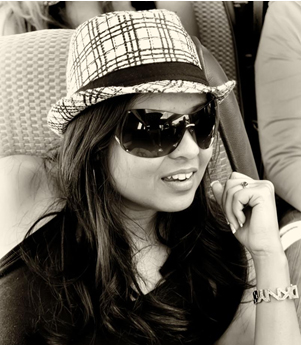With its golden hue and effervescent bubbles, Champagne is the luxury drink most associated with happy occasions and celebrations.
It is also happens to be one of my favourite all time drinks, well, on par with a chilled rose or a Cosmopolitan, when the occasion doesn’t call for bubbles!

With the current Pandemic ongoing, larger celebrations may be on hold temporarily, but in the spirit of Global Champagne Day, I thought that I would celebrate by sharing some memories of my time in Champagne, at what now seems like a simpler era….

But first, where is Champagne?
This small wine district is a mere hour’s train ride away from Paris, and is often overlooked in favour of the more “serious” wine regions like Bordeaux and Burgundy.
Champagne had always been high on the places to explore on my Wanderlustlist and I jumped at a chance to set Footsteps in this glorious region.
The thought of having no excuse at all to indulge in endless Champagne drinking, visiting some of my favourite Champagne Houses, discovering new ones, and of course seeing the home of Dom Perignon, was something I needed no convincing of!

What does the word Champagne mean to you?
Many use the word Champagne as a generic term to describe a sparkling wine, or any wine with bubbles.
Some out of the box thinkers suggest that it refers to a colour. It is even used as a descriptive word for a moment in time, something referred to as a “champagne moment”.
In reality though, Champagne is a sparkling wine produced in the Champagne region of France, using specific grapes and vineyard practices.
Chardonnay, Pinot Noir and Meunier varietal grapes are blended in specific quantities by various Champagne houses, to create their own signature tastes.

Champagne has to be produced using a fermentation process known as the Methode Cap Classique, and only those wines that have been produced under the rules of this appellation can be called Champagne.
The long and the short being: it is actually illegal to officially label any sparkling product “Champagne” unless it comes from Champagne, and abides by the rules of the appellation.
As snooty as this may sound, when you delve into the histories of some of the Champagne Houses and learn what the process of making it involves, the snobbery is somewhat forgiven!

Dom Pierre Perignon and Champagne
One of many theories floating around is that this liquid was discovered by Benedictine Monks, in particular, Dom Perignon.
Some say that sparkling wine was invented by the English and so bubbly wine was invented way before Dom Perignon discovered it, but I prefer to believe the “Dom Theory” because, being a romantic at heart, this to me is the more romantic version.
Champagne was created because the Benedictine monks tried to emulate the wines from the Burgundy region and didn’t succeed. The harsh winters in the Champagne region meant that the wine didn’t ferment in the manner expected, and the bottles burst with the pressure of the bubbles during the fermentation process.
Dom Perignon, the cellar master at the abbey in Hautvillers made a significant contribution to the production of Champagne, by adding a second fermentation to already fermenting wine, and further discovering a technique to create white wine from red grapes.
Although may theories claim that he cannot be credited with the actual invention of Champagne, Dom Perignon is certainly famous today for what is one of the most prestigious brands of Champagne in the world.

Hautvillers: The Home of Dom Perignon
I couldn’t pass up a visit to what is rumoured to be the “birthplace” of Champagne: the pretty village of Hautvillers, in the Vallee de Marne.
This little village is on the touristic Route du Champagne, and only a 15 minute drive away from Epernay, where most of the prestigious Champagne houses have their mansions and maisons.
Pretty as a postcard, wanderlusting in the rues of this little village was a dream. We did try to find the abbey where Dom Perignon made his discovery, but found out that this is now privately owned by LVMH. Still, it was lovely to be waltzing in the rues where Dom Perignon once walked!

Wine Tasting at Au 36, Rue Dom Perignon
Set in the heart of Rue de Dom Perignon, this slinky wine boutique was the perfect place to sample different blends of the regional grapes, and to enjoy a leisurely lunch.

The little cellar has statues of Dom Perignon and I was quite enchanted with the whole set up: there was something indescribably special about being at Au 36.

The wine sample choices come in a range of 2, 3, 4 or 6 flutes or, if you fancy it, you can indulge in whole bottles.
Wanderlustmate M and I opted for 4 flutes which had pretty decent samples of Chardonnay, Meunier, Pinot Noir and a blend called Assemblage. Given that Wanderlustmate M was driving and I was doing most of the drinking, this combination worked perfectly.

The wine was memorable, crisp and well balanced but the food left a lasting impression on my palette. Beetroot mousse served with pieces of trout and a parmesan crumble, potato cakes with ham from Reims, Champenois meatloaf and my personal favourite: pink biscuit and raspberry mousse macaron which went perfectly with the wine.

Rue de Champagne, or Avenue de Champagne

Welcome to the most expensive avenue in the world!
Rue de Champagne can be compares to the Champs-Élysées of the Champagne world, partly because of the famous names that line its throughfare. Moët & Chandon, Perrier-Jouët, De Venoge Pol Roger among other premier champagne producers have their maisons and mansions along Avenue de Champagne, behind the signature black wrought iron gates and fences. The amazing thing is that this isn’t even where the real value begins!
But what makes it the most expensive avenue, even more so than the Champs-Élysées in Paris or Fifth Avenue in New York?

The answer is: a secret underground world hidden from view, cellars and caves, connected by a maze of labyrinthine tunnels, stocked to the brim with bottles upon bottles of champagne.
All the Champagne Houses along the avenue have their cellars underground, and with each spanning more than 20 kilometres in length, the rough estimated number of bottles of champagne that lie underneath Avenue de Champagne is 200 million.
Yes, you read right, 200 MILLION bottles of bubbly, and this is just a rough estimate because most, if not all maisons keep the exact number of bottles in their cellars confidential. Isn’t that just fascinating?
Setting Footsteps in the Cellars of Moët & Chandon
As cliché and “touristy” as it may be to visit such a well-known brand, I unapologetically enjoy the Champagne from this label and so, visiting the cellars was something I was really excited about.
Moët & Chandon in Epernay offer guided tours of their wine cellars in various languages: and even though regular readers of this blog will know I am not the biggest fan of group tours, I made an exception to this rule for Moët!

The labyrinthine tunnels, the oldest of which dates to the foundation of the Company in 1743 are an exceptional part of its heritage. The cellars run for 28 km underneath the Avenue de Champagne, making them the largest cellar tunnel network in the Champagne region.
Moët’s tunnels are dug from the colossal white chalk stone of the Champagne region and spread across several levels underneath the city, which provides the coolness and humidity necessary for the slow maturing of the famous bubbles.
Sophie our guide led us through one dimly lit tunnel after another, the warm glow bouncing off the chalk walls. Of course, she was keeping us well informed with facts and figures, but I was more mesmerised by the endless rows of bottles in the cellars!

There are numerous vaults underground and bottles of the most famous vintages are kept well protected. We got a peek in at the gated vault where some of the most precious vintages and bottles of Dom Perignon are housed, but that was all that was allowed, and our question on the exact number of bottles in the cellar….went unanswered!

Our wine cellar visit lasted about an hour, and ended with a Champagne tasting session with the Moët & Chandon’s sommeliers in the fabulous tasting room, which was very instagrammable!

Saving the best experience for last, here’s….
Setting Footsteps inside Maison Perrier- Jouët

I feel like I have stepped back into another era, as we set footsteps beyond the iron gates of Maison Perrier-Jouët. Tingling with excitement, I cannot wait to see what lies behind the secret doors of this Champagne House, because it is not open to the public.
Wanderlustmate M and I are on a private tour of Maison Belle Epoque, the historic 18th Century Mansion, once home to the Perrier family, and now a museum dedicated to their love of bubbles and Art Nouveau.

The Belle Epoque Mansion houses Europe’s largest private collection of French Art Nouveau, some pieces being priceless and rare. The furnishings and decorations in the Mansion are a collection of works created by the art movement’s greatest designers, some of which are pointed out to us with a brief description of their history and how they fit in with the theme of this Mansion.

Beneath the wooden floorboards of the Mansion lie the mysterious wine cellars that very few get to see, and where bottles of their finest bubbles are left to age.
Our host leads us down into the cellar, opening a crested iron gate with a key not from this century. We are led into the tunnels where Magnums stand in wooden riddling racks lining the walls of the dimly lit cave. The Belle-Epoque Aisle, particularly beguiling, with its hand painted bottles adorned with a spray of Japanese white anemones synonymous with the brand. Outside, it is a balmy summers day, but here in the cellar, the temperature kept to a constant 11 degrees to allow the bubbles to work their magic within the bottles.

Art installations break the otherwise long chain of tunnels, specially commissioned by the House. We come across the first one, Lost Time by Glithero.
The low light of the tunnel bounces off a pool of water, making it look like a lake. A series of beads on strings draped like cobwebs off the ceiling hang over this base of water, the overall effect nothing short of mesmerising. The muse behind this installation: Champagne bubbles.

We are shown “Eden”, the heart and soul of the Mansion which houses two of oldest and most precious bottles of this Maison: from way back in 1825 and 1842! Eden is its own little ecosystem, behind locked grills bearing the Perrier-Jouët crest.


Back inside the Maison Belle-Epoque, our host takes us past more interesting art installations that seem to move with us, to the bar, where a Japanese artist has created a glass mobile from Murano glass that hangs above the ceiling.

A bottle of Perrier- Jouët’s signature Belle Epoque 2007, hand painted with the iconic flower is popped open, and flutes handed, as we toast to our tour and to this Champagne dynasty.


Iconic and captivating, enjoyed in the Maison Belle-Epoque’s garden, I am nothing short of grateful to have had this experience.

Here’s raising a toast to all the fabulous Champagne Houses, and to Global Champagne Day!
Until next time, thank you for wanderlusting in Champagne with me, keep safe until we can wanderlust again someday soon!










